Tour Historic Matteson

 Named after the 10th governor of Illinois, Matteson is one of the oldest communities outside of Chicago. Platted in 1855, this German settlement quickly became an agricultural trade center because of its strategic location to the three railroad lines. By 1897, Matteson had grown to 500 residents, but time stood still in the village until after World War II, when many returning GI's sought housing. By 1960 the population of Matteson grew from 819 residents to 3,225.
Named after the 10th governor of Illinois, Matteson is one of the oldest communities outside of Chicago. Platted in 1855, this German settlement quickly became an agricultural trade center because of its strategic location to the three railroad lines. By 1897, Matteson had grown to 500 residents, but time stood still in the village until after World War II, when many returning GI's sought housing. By 1960 the population of Matteson grew from 819 residents to 3,225.
Today Matteson is the commercial center of the southern suburbs maintaining steady, progressive growth in residential as well as retail development.
Village of Matteson
"Crossroads of Heritage and Progress"
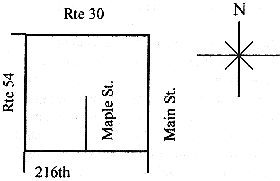 Before you go...
Before you go...
Tour Historic Matteson was designed to be a one-day, two-part tour of Matteson. While it is possible to walk through Old Matteson (#1-10), transportation is necessary to visit sites #11 & 12.
Please note that the houses on the tour are private residences and are not the property of the Matteson Historical Society--please respect their privacy and property.
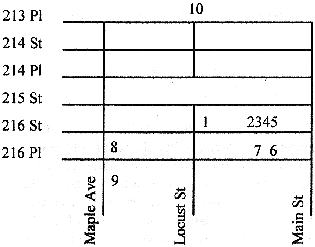
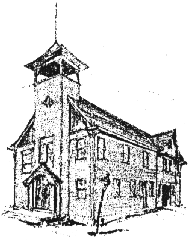 1. Matteson Village Hall Site
1. Matteson Village Hall Site
215th Locust Streets
On this site in 1897, the Matteson Village Hall was built at a cost of $3,225.00. Built to house the Police and Fire Departments, the hall also contained a large room on the second floor which served as the meeting place for social gatherings, like dances. The bell in the belfry served to sound the dire fire alarm and a nightly 9:30 pm curfew. Although the building was demolished in 1948, some of the stones from the foundation were used in the construction of the military memorial in Memorial Park.
2. Henry Gross Home & Harness Shop
3624 W. 216th Street
About twenty years after the platting of Matteson, the Henry Gross Home and Harness Shop was erected on this site in 1875. The harness shop was operated from the west half of the structure and could be entered through a double door. The east half of the building contained the living quarters for the family, who also enjoyed a large porch that extended across the entire front of the building. The house remained in the Gross family until 1960, when it was sold to the Henry Lehmanns. They did extensive remodeling, both inside and outside, and enclosed the porch that became the Lehmann law office. Bill Motlong purchased the house in 1990 for his Center for Personal and Family Life with a group of psychotherapists. Architect Deaver Rockwell of Olympia Fields was hired to maintain any remaining historical value; however, skylights were added, not visible from the outside. Original structural beams and foundation remain.
3. Hahne Family House
3616 W. 216th Street
Erected in 1860 by William Hahne, this building remains one of the oldest residences in Matteson. Characterized as Victorian Gothic, the details and ornamentation remain unchanged. In the rear of the house is a small structure erected in 1914 to serve as a slaughterhouse for the Muff family business. Amanda Muff, the daughter of William Hahne, lived in the house until her death in 1974 at the age of ninety-one. the building was purchased by Pierre Bonnefil in 1975, for his beauty salon and later an art gallery. Notice the original hardwood floors. There also is a photograph of William Hahne hanging in the stairway. The slaughter house in the rear of the property has been remodeled into an apartment and currently is rented.
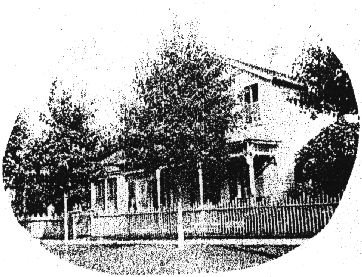
4. Village Barber Shop
3612 W. 216th Street
Established by Rudolph Adam in 1896, this structure has continued to serve the Village residents as a local barber shop. It is noted that in 1919 haircuts were 40¢ and shaves were 20¢. In order to provide a variety of services, a pool room was located on the premises as were bathing facilities for men at a cost of 35¢. Business was so brisk at times that patrons had to take a number in order to be served. News and conversation served to pass the time of day, as it still does today. The red and white barber pole is an original feature. Owned now by Lucille Walker, she has rented the apartment in the rear. The barber shop is still considered the oldest continuously operated barber shop in the State of Illinois. An original barber chair is in the Matteson Historical Museum.
 5. German American Bank
5. German American Bank
3610 W. 216th Street
Established in 1904, the German American Bank opened its doors for business in Matteson with H. C. H. Stege as president. In 1917, the name of the bank was changed to the First State Bank of Matteson, but the old name was never removed from the façade of the building. The bank served Matteson and area residents until it closed its doors in 1937. The building became home to Campe Insurance in 1952, and now houses Serendipity, a crafts and antiques shop, operated by members of the Campe family. The building still has the original tin on the walls, the original bank safe and the original teller windows with bulletproof glass and a gun porthole at every other window. There also are remaining 250 brass deposit boxes and the wooden desk attached to the wall where deposit slips were filled out.
6. Maloni Tavern
3601 W. 216th Street
In 1865, the building erected on the southeast corner of Main & 216th Streets was twice the width of the present structure. When the Illinois Central Railroad was elevated in 1922 and later electrified in 1926, it became necessary to remove the east half of the building. Even though the appearance of the structure was altered, the building has been operated as a tavern since 1889. Former owners include F. Brueggemann, W. Krabbee and E. Langworth. From 1921-1994 the tavern served Matteson under the Maloni family name. Friday night fish fries were popular and homemade sandwiches were available. There also was a pool table to increase income. There is an apartment upstairs, but since Pascal (Pat's) retirement in 1993, the business is closed.
7. Dettmering's Tavern
3616 W. 216th Street
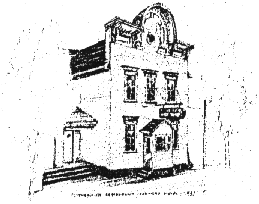 The building formerly known as the "Farmer's Hotel" was erected by William Arnold in 1880. The original building consisted of the saloon, kitchen, summer kitchen, dining room, parlor and bedroom. Upstairs were 13 lodging rooms with no heat and minimum necessities. A large scale was located in front of the tavern where farmers checked the weight of their loads before proceeding to the grain elevator. When Matteson's volunteer fire department was organized in 1894, the fire station's siren was located behind a picture on the tavern wall. The tavern was owned and managed by four generations of Dettmerings since 1890. The building presently houses Ciao Ristorante, a restaurant featuring Italian cuisine. Part of the bar is original to the building; part of the bar is in the Matteson Historical Museum, along with other original artifacts from Dettmerings. In the 1980s the building was given its "painted lady" look. Rosetine Seminara, the present owner, has added a veranda and canopy for outdoor dining.
The building formerly known as the "Farmer's Hotel" was erected by William Arnold in 1880. The original building consisted of the saloon, kitchen, summer kitchen, dining room, parlor and bedroom. Upstairs were 13 lodging rooms with no heat and minimum necessities. A large scale was located in front of the tavern where farmers checked the weight of their loads before proceeding to the grain elevator. When Matteson's volunteer fire department was organized in 1894, the fire station's siren was located behind a picture on the tavern wall. The tavern was owned and managed by four generations of Dettmerings since 1890. The building presently houses Ciao Ristorante, a restaurant featuring Italian cuisine. Part of the bar is original to the building; part of the bar is in the Matteson Historical Museum, along with other original artifacts from Dettmerings. In the 1980s the building was given its "painted lady" look. Rosetine Seminara, the present owner, has added a veranda and canopy for outdoor dining.
7b. Mahler's Service, Inc.
3627 W. 216th Street
Owned and operated for the past 86 years by the Mahler family, the garage has serviced all makes of cars. At one time, Mahler's was a Mitchell and Maxwell car dealership; later, a Nash dealership; and still later, a Chevrolet and Buick dealership. While servicing the few cars around in 1914 when Art Mahler started the business, farm implements also were sold. The original office is across the aisle from the present one. A wall of historic photographs is located in the front office.
8. Nortmeier House
3735 W. 216th Street
The clean, simple lines of the Nortmeier house have found a place in the history of American-Midwest architecture and in the history of those families who settled into the area. The house was built on the southeast corner of Maple and 216th Streets in 1894. The outside appearance of the house has not been altered significantly since its construction by Henry Stege, a local carpenter who constructed homes in early Matteson. Early photographs show that once a white picket fence surrounded the two-story frame house. Recent owners Dr. and Mrs. Peter Iagmin purchased the house in the early 1960s. Their renovation tried to preserve any of the original elements that could be salvaged. Downstairs is a living room, dining room, kitchen, bath, and one small bedroom that appears to once have been two even smaller rooms. The upstairs has two bedrooms, one smaller room, and one bath. Original woodwork appears to be cherry, but it has been painted over numerous times through the years. A walnut railing upstairs was partially restored because an extra section of the original railing was located stored in the attic. One of the nicest features of the interior is the sliding door with glass panels located between the dining room and the living room. Eric and Julie Haberichter purchased the Nortmeyer house and are doing extensive restoration.
 9. Zion Evangelical Lutheran Church
9. Zion Evangelical Lutheran Church
216th Place & Maple Avenue
On September 19, 1878, members of the Immanuel Luthern Church decided to form their own congregation: Zion Evangelical Lutheran Church. Conducting services in the existing Lutheran School, the church had trouble attracting a full-time minister. In 1884, the Rev. Ernst Kirchner became the first full-time minister at a salary of $400 per year. Five years later the congregation decided to build a new church at the unheard of sum of $2,900. The new church was located east of the school; and, in 1898, the school was moved around the corner so that a parsonage could be constructed. In 1927, it was voted to exchange church and parsonage locations, so the church would be on the corner. At that time, the steeple was removed. The original Zion Church has stood vacant for over 15 years.
9b. Herman Stege House
3720 W. 216th Place
Herman Stege, a local carpenter, built many houses in Matteson, including his own. Erected in 1889, special features included a carriage sidewalk and an open porch extending across most of the front of the house. There is an unique small, stained glass window on the west side of the porch. Special interior features include a "Betsy Ross" front stairway to the second floor as well as original woodwork. The house was purchased by Juan Monroe and Yolanda Vega in 1998. They also are in the midst of extensive interior remodeling. The leaded glass windows on the front are original, as are the hardwood floors and wood paneling in the living room.
10. Matteson Public School Site
213th Place & Locust Streets
In 1853, Jacob Riehl deeded one-quarter acre of land for the use of a public school. Early records indicate that in 1860 George E. Dolton was appointed teacher of the one-room school at a salary of $148 a term. By 1865, an election was held to levy a tax to construct a larger school at a cost of $2000. even then costs exceeded expectations, and the following year the directors obtained a loan for an additional $500. By 1876, a second floor was added; and in 1916, a brick two-story building replaced the old wooden structure. In 1928, a gymnasium and additional classrooms were added. The part of the building in front is the newest. The older section can be seen in the rear.
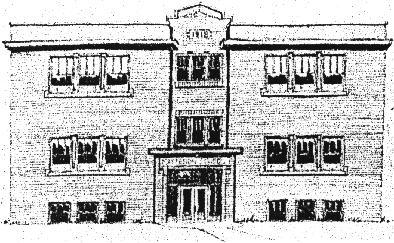
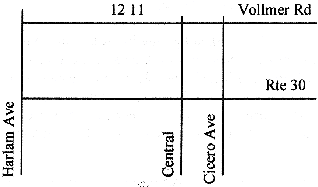 11. St. Paul Evangelical Lutheran Church
11. St. Paul Evangelical Lutheran Church
6200 Vollmer Road
The congregation, composed primarily of German Lutheran immigrants, was founded in 1867. Before the present church building was erected in 1883 at a cost of $3,500, the congregation held services in parishioner's homes as well as in the parochial school building on the south side of Vollmer Road. Upon entering St. Paul Church, the first thing usually seen is the German wording above the arch at the chancel: "Selig sind die Gottes Wort horen und bewaren". One of the church's first remodelings took place in 1937. At that time, this plaque was covered up, probably because of war feelings toward the Germans. A complete church renovation in 1983 uncovered these words, which were incorporated in the new church: "Blessed are they who hear the Word of God and keep it". Funeral services began alongside the casket at the cemetery. From there mourners moved to the church because the original church had doors too small to accommodate a casket. In 1922, wider entrance doors were installed. While improvements have been added through the years, the church has been lovingly restored and retains much of its original charm.
12. Sieden Prairie School
6200 Vollmer Road
 Sieden Prairie School, District 159, was built in 1869 on Vollmer Road. The original schoolhouse contained one classroom and two cloakrooms. The Lutheran children attended morning classes across the street at the German Lutheran School, and spent their afternoons and all day Friday at the Sieden Prairie Public School. Many students spoke only German on their first day of school and this arrangement accommodated most of the German speaking population. English lessons were taught very much in the same manner as today, with the only difference being the use of the old slate blackboards. In the 1940s, the school was remodeled to include another classroom, an entrance hall, a small library, and indoor plumbling. The school was closed in 1962; in 1965, it was rented out for special education classes. Since 1972, it has been a storage facility for District 159, who today are enlarging in the rear for administrative offices. The Historical Society plaque will be removed and replaced when siding repairs are completed by next spring.
Sieden Prairie School, District 159, was built in 1869 on Vollmer Road. The original schoolhouse contained one classroom and two cloakrooms. The Lutheran children attended morning classes across the street at the German Lutheran School, and spent their afternoons and all day Friday at the Sieden Prairie Public School. Many students spoke only German on their first day of school and this arrangement accommodated most of the German speaking population. English lessons were taught very much in the same manner as today, with the only difference being the use of the old slate blackboards. In the 1940s, the school was remodeled to include another classroom, an entrance hall, a small library, and indoor plumbling. The school was closed in 1962; in 1965, it was rented out for special education classes. Since 1972, it has been a storage facility for District 159, who today are enlarging in the rear for administrative offices. The Historical Society plaque will be removed and replaced when siding repairs are completed by next spring.
The name Sieden Prairie is descriptive of the area. There were no trees, therefore the name "prairie". "Sieden" means "low, marshy land".
The Matteson Historical Society was officially incorporated in 1975 as a not-for-profit organization with the primary purpose to bring together people in Matteson to preserve and collect written and printed materials, artifacts and memorabilia of all kinds illustrative to Matteson's history and heritage.
Membership in the Historical Society is open to all for a nominal fee. The museum is open Mondays, Wednesdays and Thursdays from 9-5. For more information, please call the museum at 708.748.3033.
813 School Street, Matteson, IL 60443
Celebrating "The History Around Us"
Have you found this page useful or interesing? If so, please join the free Historians Club. We wish to have lots & lots of members so that we can have more features. Questions, complaints, suggestions, additional links? Please e-mail the webmaster.
This page is at https://ianhistor.tripod.com/hlmkr/matteson/index.html.
This page developed 11th July, 2000, for Cynthia Ogorek. Updated 9th October.

 1. Matteson Village Hall Site
1. Matteson Village Hall Site

 Before you go...
Before you go...

 The building formerly known as the "Farmer's Hotel" was erected by William Arnold in 1880. The original building consisted of the saloon, kitchen, summer kitchen, dining room, parlor and bedroom. Upstairs were 13 lodging rooms with no heat and minimum necessities. A large scale was located in front of the tavern where farmers checked the weight of their loads before proceeding to the grain elevator. When Matteson's volunteer fire department was organized in 1894, the fire station's siren was located behind a picture on the tavern wall. The tavern was owned and managed by four generations of Dettmerings since 1890. The building presently houses Ciao Ristorante, a restaurant featuring Italian cuisine. Part of the bar is original to the building; part of the bar is in the Matteson Historical Museum, along with other original artifacts from Dettmerings. In the 1980s the building was given its "painted lady" look. Rosetine Seminara, the present owner, has added a veranda and canopy for outdoor dining.
The building formerly known as the "Farmer's Hotel" was erected by William Arnold in 1880. The original building consisted of the saloon, kitchen, summer kitchen, dining room, parlor and bedroom. Upstairs were 13 lodging rooms with no heat and minimum necessities. A large scale was located in front of the tavern where farmers checked the weight of their loads before proceeding to the grain elevator. When Matteson's volunteer fire department was organized in 1894, the fire station's siren was located behind a picture on the tavern wall. The tavern was owned and managed by four generations of Dettmerings since 1890. The building presently houses Ciao Ristorante, a restaurant featuring Italian cuisine. Part of the bar is original to the building; part of the bar is in the Matteson Historical Museum, along with other original artifacts from Dettmerings. In the 1980s the building was given its "painted lady" look. Rosetine Seminara, the present owner, has added a veranda and canopy for outdoor dining.

 11. St. Paul Evangelical Lutheran Church
11. St. Paul Evangelical Lutheran Church
 Sieden Prairie School, District 159, was built in 1869 on Vollmer Road. The original schoolhouse contained one classroom and two cloakrooms. The Lutheran children attended morning classes across the street at the German Lutheran School, and spent their afternoons and all day Friday at the Sieden Prairie Public School. Many students spoke only German on their first day of school and this arrangement accommodated most of the German speaking population. English lessons were taught very much in the same manner as today, with the only difference being the use of the old slate blackboards. In the 1940s, the school was remodeled to include another classroom, an entrance hall, a small library, and indoor plumbling. The school was closed in 1962; in 1965, it was rented out for special education classes. Since 1972, it has been a storage facility for District 159, who today are enlarging in the rear for administrative offices. The Historical Society plaque will be removed and replaced when siding repairs are completed by next spring.
Sieden Prairie School, District 159, was built in 1869 on Vollmer Road. The original schoolhouse contained one classroom and two cloakrooms. The Lutheran children attended morning classes across the street at the German Lutheran School, and spent their afternoons and all day Friday at the Sieden Prairie Public School. Many students spoke only German on their first day of school and this arrangement accommodated most of the German speaking population. English lessons were taught very much in the same manner as today, with the only difference being the use of the old slate blackboards. In the 1940s, the school was remodeled to include another classroom, an entrance hall, a small library, and indoor plumbling. The school was closed in 1962; in 1965, it was rented out for special education classes. Since 1972, it has been a storage facility for District 159, who today are enlarging in the rear for administrative offices. The Historical Society plaque will be removed and replaced when siding repairs are completed by next spring.

